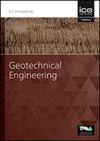多层土中抗扭桩分析的刚度矩阵法
IF 1.7
4区 工程技术
Q3 ENGINEERING, GEOLOGICAL
Proceedings of the Institution of Civil Engineers-Geotechnical Engineering
Pub Date : 2021-12-08
DOI:10.1680/jgeen.21.00140
引用次数: 1
摘要
提出了一种新的、简单实用的方法来研究均匀或非均匀多层弹性土上扭转荷载桩的响应。土的非均匀性是通过假设每一层的剪切模量分布符合二次函数来解释的。多层土中桩的分析是通过将桩在土-土层和土-气界面处细分为多个单元,然后使用传统的矩阵方法(如结构分析中常用的方法)将它们连接起来进行的。采用微分变换法求解了单个结构单元的控制微分方程。其次,通过在单元的两端应用相容性条件推导出刚度矩阵。部分或全部嵌入多层并受到扭转的桩可以用所提出的公式以简单的方式进行分析-与其他可用的解决方案相比,这是一项繁琐的工作。最后,给出了矩阵系数的显式表达式。给出了四个例子来说明所提出的公式的简单性、准确性和能力。本文章由计算机程序翻译,如有差异,请以英文原文为准。
Stiffness matrix method for analysis of torsionally loaded piles in multi-layered soil
A new, simple, and practical method to investigate the response of torsionally loaded piles on homogeneous or non-homogeneous multi-layered elastic soil is developed. The soil non-homogeneity is accounted for by assuming for each layer a shear modulus distribution that fits a quadratic function. The analysis of piles in multi-layered soil is carried out by subdividing the pile, at the soil-soil layer and soil-air interfaces, into multiple elements, and then using conventional matrix methods -such as those commonly implemented in structural analysis- to connect them. The governing differential equation (GDE) of an individual structural element is solved using the Differential Transformation Method (DTM). Next, the stiffness matrix is derived by applying compatibility conditions at the ends of the element. Piles partially or fully embedded in multiple layers and subjected to torsion can be analyzed in a simple manner with the proposed formulation -a tedious endeavor with other available solutions. Finally, explicit expressions for the coefficients of the matrix are provided. Four examples are presented to show the simplicity, accuracy, and capabilities of the proposed formulation.
求助全文
通过发布文献求助,成功后即可免费获取论文全文。
去求助
来源期刊
CiteScore
4.40
自引率
4.50%
发文量
68
审稿时长
3 months
期刊介绍:
Geotechnical Engineering provides a forum for the publication of high quality, topical and relevant technical papers covering all aspects of geotechnical research, design, construction and performance. The journal aims to be of interest to those civil, structural or geotechnical engineering practitioners wishing to develop a greater understanding of the influence of geotechnics on the built environment.

 求助内容:
求助内容: 应助结果提醒方式:
应助结果提醒方式:


